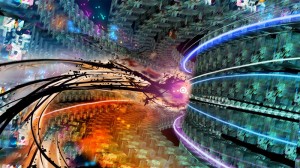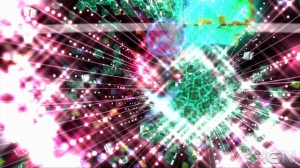 The main feature of Q Entertainment’s newest release “Child of Eden” is the least relevant one. The much-touted Kinect support is less essential and less useful than has been espoused in the games media coverage in the run up to its release. Indeed, to be competitive and achieve decent scores in the game Kinect support is useless. Its inclusion in what is ultimately a twitchy, arcade shooter has now been exposed as a shallow marketing ploy; a desperate attempt by Microsoft to obtain a hardcore experience on their minigame-friendly peripheral. If the game is not a new and innovative Kinect-based euphoric shooter though, what is it?
The main feature of Q Entertainment’s newest release “Child of Eden” is the least relevant one. The much-touted Kinect support is less essential and less useful than has been espoused in the games media coverage in the run up to its release. Indeed, to be competitive and achieve decent scores in the game Kinect support is useless. Its inclusion in what is ultimately a twitchy, arcade shooter has now been exposed as a shallow marketing ploy; a desperate attempt by Microsoft to obtain a hardcore experience on their minigame-friendly peripheral. If the game is not a new and innovative Kinect-based euphoric shooter though, what is it?
The answer is simple. It’s the sequel to Rez. The gameplay will be familiar to anyone who played the groundbreaking Lawnmower Man-esque classic on PS2 or in its recent downloadable format on Xbox Live Arcade or PSN. Just like its predecessor, constant forward inertia and scrolling trippy visuals adorn what is ultimately no more than a rail shooter, albeit a ridiculously gorgeous one. There’s nothing revolutionary about the gameplay here, you simply lock on to eight targets with your cursor and release your attacks on a variety of flying, floating, crawling or swimming enemies.
There are subtle additions though. You now have a machine-gun like attack which you use on a few specific enemies and also to shoot down enemy projectiles. Scores also multiply exponentially when you defeat enemies in time with the music. Just as new gameplay features are added other aspects have been taken away though. You no longer have an onscreen avatar like you did in Rez. Instead, the evolving protagonist of Rez is replaced with a somewhat dull and functional circular reticule.
 While Rez was firmly based in a computer world of polygons and Tron inspired angular vectors, Child of Eden is a celebration of nature and organic life. The world of Child of Eden is all spouting flowers, giant flying manta rays and cherry blossoms. While at times the moving images can become a messy blur, its when they are on the edge of recognisable flora and fauna that they are at their most dreamlike and beautiful. Sections of the levels may drift by as an indistinct series of blurry shapes and smudges but there are other parts where Child of Eden is so different and so wonderfully creative that your jaw will drop.
While Rez was firmly based in a computer world of polygons and Tron inspired angular vectors, Child of Eden is a celebration of nature and organic life. The world of Child of Eden is all spouting flowers, giant flying manta rays and cherry blossoms. While at times the moving images can become a messy blur, its when they are on the edge of recognisable flora and fauna that they are at their most dreamlike and beautiful. Sections of the levels may drift by as an indistinct series of blurry shapes and smudges but there are other parts where Child of Eden is so different and so wonderfully creative that your jaw will drop.
And the visuals are not the most impressive part of the game. The music of Child of Eden (by the band Genki Rockets) is absolutely integral to the experience. On its own it makes for a wonderful soundtrack worthy of any trance fans mp3 collection, but integrating as it does with the actions of the player and the events of the game world, its an exalting, transcendental element of the game. Tetsuya Mizuguchi has once again achieved synesthesia, his term for the combination of music, touch and sound that creates the Child of Eden experience.
 This combination of classic, Rez gameplay, astounding soundtrack and beautiful, organic visuals makes the first ten or so minutes of Child of Eden amongst the best experiences available in gaming. The expositional text espousing some quasi-mystical nonsense is a weak opening, but the images of the beautiful actress playing the character Yumi and the way the FMV video of her breaks through the virtual world is genuinely moving. As the first few levels progress you drift in and out of an impressed trance-like state. Its as close to a transcendental experience as a videogame has ever given me.
This combination of classic, Rez gameplay, astounding soundtrack and beautiful, organic visuals makes the first ten or so minutes of Child of Eden amongst the best experiences available in gaming. The expositional text espousing some quasi-mystical nonsense is a weak opening, but the images of the beautiful actress playing the character Yumi and the way the FMV video of her breaks through the virtual world is genuinely moving. As the first few levels progress you drift in and out of an impressed trance-like state. Its as close to a transcendental experience as a videogame has ever given me.
This early bliss fades all too quickly though, the come down from the high is sudden and painful. Child of Eden has three painful unavoidable flaws: its stressful, its short and its repetitive.
The game scores players based on a number of factors, but one of the most important is the number of enemies they shoot down. As a rail shooter, the player splits their time between shooting down enemy projectiles and destroying enemies. Early on you’ll be happy to simply survive the levels, but as you chase higher scores each enemy that escapes the edge of the screen becomes as frustrating as a missed note in an otherwise perfect streak in Guitar Hero. The more difficult later levels also crowd the screen with so many enemy bullets to manage and opponents to destroy that it becomes immensely challenging. While many enjoy this gameplay, its at odds with the tone and atmosphere of the game which makes it seem more cerebral and chilled than it actually is. While titles like Flower allowed the player a relaxed and fulfilling gameplay experience free of adversity, Child of Eden is a real wolf in sheeps clothing with punishing, frantic sections requiring quick reactions and precise timing. This results in Child of Eden being a game you would never play to relax or calm down. Indeed, if you were frustrated in any way Child of Eden would be the last game you would pick up to chill out.
 The disconnect between the languid atmosphere and frantic gameplay is exasperated by the way levels are unlocked. As the game is so brief (only 5 short levels), the developers have felt the need to force the player to grind early levels to unlock later ones. Rez was a game of similar length and didn’t force this on the player. As soon as the second level is complete, the player will find they need to go back and play the first two levels again to accrue enough stars to unlock the third. While the levels are supposed to change based on the players performance each time, the truth is that the basic structure and events of the level are much the same every time. After beating a tough boss, the appeal of going back and playing an already complete level is pretty low. The fact that the music is so wonderful, but that you are forced to become over-exposed to it feels awful. Its like the first Rock Band, where you had to play the same songs over and over until you hated them. The first level of Child of Eden is wondrous, but already it is painfully over familiar.
The disconnect between the languid atmosphere and frantic gameplay is exasperated by the way levels are unlocked. As the game is so brief (only 5 short levels), the developers have felt the need to force the player to grind early levels to unlock later ones. Rez was a game of similar length and didn’t force this on the player. As soon as the second level is complete, the player will find they need to go back and play the first two levels again to accrue enough stars to unlock the third. While the levels are supposed to change based on the players performance each time, the truth is that the basic structure and events of the level are much the same every time. After beating a tough boss, the appeal of going back and playing an already complete level is pretty low. The fact that the music is so wonderful, but that you are forced to become over-exposed to it feels awful. Its like the first Rock Band, where you had to play the same songs over and over until you hated them. The first level of Child of Eden is wondrous, but already it is painfully over familiar.
The ultimate truth of Child of Eden is that it is a very small amount of (very good) content, pumped up like a puffer fish trying to look much bigger than it actually is. As soon as you take it home and play it for an hour it deflates, becoming a very small thing indeed. There is simply not enough in this game to sell it for full price. The Kinect support is a novelty. The rythym based scoring element adds a level of complexity for hardcore players, but the act of mastering it across the same five levels would be tedious beyond compare. In a market where publishers are worried about games being traded in when gamers are bored with them, Child of Eden is baffling. This is a game that everyone must play, but that no one should ever buy. Rent it, borrow it, accept it as a gift, but do not pay for it.
6 deflated-but-delicious mouthfuls out of 10
